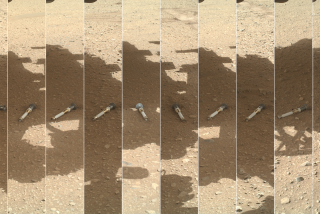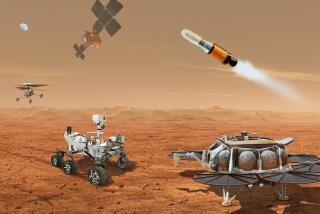Curiosity rover hit the perfect spot on Mars, scientists say
NASA’s Curiosity robot not only survived its elaborate landing on Mars but also wound up in the most scientifically exciting pocket of its 48-square-mile target area on the floor of an ancient crater, space scientists said Monday.
Engineers pored over data to figure out precisely where the spacecraft landed Sunday — and determined that Curiosity’s science, which has the potential to transform deep-space exploration, won’t start at the base of a mountain four miles away, but right under its nose.
Curiosity landed in a geological feature called an alluvial fan, a plain of rocks and dirt likely deposited by a river during Mars’ ancient, watery past. When it comes to Curiosity’s primary mission, the search for evidence that Mars is or was able to foster life, the fan could be “a jackpot,” said Caltech geologist John Grotzinger, the mission’s lead scientist.
“This place is awesome,” Grotzinger said in an interview at the Jet Propulsion Laboratory in La Cañada Flintridge, which is managing the $2.5-billion mission for NASA. “We really don’t want to blow out of there.”
Curiosity, a six-wheeled geochemistry lab and the most sophisticated machine ever sent to another planet, landed in Gale Crater on Sunday night — a crisp, late-winter afternoon on Mars.
Much of the discussion about Curiosity had focused on its intricate landing sequence, which had never been attempted and could never be vetted on Earth because of atmospheric differences.
When it worked, a cascade of joy and relief washed over the JPL campus. But scientists took pains to point out Monday that the moment of triumph was not a climax, or an ending. Curiosity was not built to put on a splashy, one-night show, said mission systems manager Michael Watkins, “but to drive over Mars and execute a beautiful science mission.”
Interactive: Curiosity: Liftoff to landing
After a few weeks of tests to make sure Curiosity’s instruments are working, a significant order of business will be to figure out where to drive first.
Curiosity is known in engineer-speak as a “go-to” mission, meaning it was designed to land in one place and then go to another.
The ultimate target, and the reason Gale Crater was selected as a landing zone, is the towering and unusual mountain in the center of the crater. Known as Mt. Sharp, it is taller than any in the Lower 48 United States, and scientists believe its walls were eroded over millions of years, either by wind or water, and contain a preserved record of Mars’ history and evolution.
Curiosity could have wound up anywhere in its landing target, an ellipse measuring 12 miles by 4 miles. Scientists had long been attracted to the fan in addition to the mountain, but there were no guarantees that Curiosity would land on or even near the fan.
Now, Curiosity doesn’t have to “go-to” much of anywhere any time soon because there’s too much science to do right in the neighborhood, where running water appears to have swept debris from the northern rim of the crater into its bowl. The spot is at about the 11 o’clock position in the crater, a little more than a mile east of the center of the landing ellipse, and about 14 miles from the north wall of the crater.
Space scientists are so fascinated by the possibility of taking a close look at an alluvial fan on Mars that they very nearly chose a different spot — a site that appeared to be the petrified remnants of a river delta, similar to where the Mississippi River spills into the Gulf of Mexico.
“We get a free sample,” Grotzinger said. “The place we landed looks pretty darn interesting. We want to check it out.”
Curiosity will explore the alluvial fan and then “head for the hills,” Watkins said.
Curiosity’s primary mission is expected to last for at least one Martian year, or 687 Earth days, a luxury compared with primary missions of previous Mars projects that lasted months. What’s more, the nuclear-powered rover could easily operate for twice that long — four years — officials said Monday.
Still, the presence of solid science within arm’s reach was something of a relief for senior space officials, who knew that Curiosity would otherwise face pressure to “blaze out across the plains,” as Grotzinger put it.
“We’re in no hurry,” said Pete Theisinger, Curiosity’s project manager. “We have a priceless national asset here. And we are not going to — pardon the French — screw it up.”
Also Monday, scientists said their initial reviews of Curiosity indicated that its suite of geochemistry instruments — lasers that can vaporize rock, scoops that can ingest dirt to test for the presence of minerals — survived the landing and would operate properly.
The spacecraft could have survived landing on a slope steeper than many expert ski runs. But it found a far gentler angle, landing with its nose pointed down at less than 4 degrees.
“We landed pretty much on this table right here,” said Watkins, patting his palm on a briefing-room table.
Scientists also released an extraordinary photograph taken during Curiosity’s landing sequence by a passing satellite. The photo clearly showed Curiosity in its final seconds of flight, headed toward Mars beneath a fully inflated parachute.
The image was captured by a camera on the Mars Reconnaissance Orbiter known as HiRISE, which also played a key role in NASA’s choice of Gale Crater.
“HiRISE has taken over 120 pictures of Gale,” said JPL scientist Sarah Milkovich. She smiled broadly. “But I think this is the coolest one.”
By Monday, Curiosity’s success — so widely followed that NASA’s websites crashed in the minutes after the landing — had instantly reinvigorated proponents of deep-space, planetary exploration.
NASA, like many government agencies, faces an uncertain financial future. President Obama’s proposed NASA budget for the 2013 fiscal year, $17.7 billion, was fairly flat. But it prompted the space agency to make difficult decisions, including a $300-million cut to planetary science, JPL’s specialty.
The cut bewildered critics because it was made in what is viewed as a golden age in robotic space exploration, with the Mars program NASA’s crown jewel. Proponents of robotic exploration have worked to restore $100 million and pledged to seize on the enthusiasm generated by Curiosity to fight for the rest.
Rep.Adam B. Schiff (D-Burbank) said in an interview that deep-space backers would also try to get canceled Mars missions “back on track.” NASA, for example, had pulled out of two partnerships with the European Space Agency to explore Mars. Those missions are viewed as important because they could lead to technology allowing for soil samples to be returned from Mars to Earth — a crucial next step in the search for signs of life.
“I hope NASA will be infected by the enthusiasm and will reconsider,” Schiff said. “It’s what the public wants. We owe a lot to the Mars program. NASA should not forget that.”
Caltech President Jean-Lou Chameau agreed that Curiosity was “energizing public support” for space exploration. “We’re going to work very hard to ensure that there is sufficient funding and that the U.S. stays on the leading edge of space exploration,” he said.
Times staff writer Jon Bardin contributed to this report.







